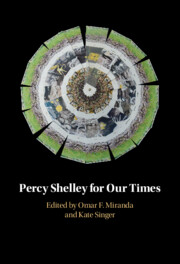Book contents
- Percy Shelley for Our Times
- Reviews
- Percy Shelley for Our Times
- Copyright page
- Contents
- Notes on Contributors
- Acknowledgments
- Abbreviations
- Introduction
- 1 Shelley, Treaty-Making, and Indigenous Poetry
- 2 Waiting for the Revolution
- 3 “A Chamæleonic Race”
- 4 Dream Defenders and the Inside Songs
- 5 Radical Suffering
- 6 Loathsome Sympathy
- 7 Hopeless Romanticism
- 8 Percy Shelley’s Sad Exile
- 9 Shelley in the Overgrowth
- 10 Creatrix Witches, Nonbinary Creatures, and Shelleyan Transmedia
- 11 Action at a Distance
- 12 Educating the Imagination/Defending Shelley Defending
- Further Reading
- Index
10 - Creatrix Witches, Nonbinary Creatures, and Shelleyan Transmedia
Published online by Cambridge University Press: 07 March 2024
- Percy Shelley for Our Times
- Reviews
- Percy Shelley for Our Times
- Copyright page
- Contents
- Notes on Contributors
- Acknowledgments
- Abbreviations
- Introduction
- 1 Shelley, Treaty-Making, and Indigenous Poetry
- 2 Waiting for the Revolution
- 3 “A Chamæleonic Race”
- 4 Dream Defenders and the Inside Songs
- 5 Radical Suffering
- 6 Loathsome Sympathy
- 7 Hopeless Romanticism
- 8 Percy Shelley’s Sad Exile
- 9 Shelley in the Overgrowth
- 10 Creatrix Witches, Nonbinary Creatures, and Shelleyan Transmedia
- 11 Action at a Distance
- 12 Educating the Imagination/Defending Shelley Defending
- Further Reading
- Index
Summary
This chapter considers Shelley’s attempt to think before the “Error and Truth” of Enlightenment humanity, and before the binaristic split between the white male bourgeois Human and those not included in those definitions of humanity. Tracing his iconoclastic resistance to normative categories of gender, race, and the human as well as his idealistic attempt to recreate those categories in a reading of The Witch of Atlas, with its double creation of Witch and the Witch’s “sexless” creature, the chapter explores the poet’s radical understanding of gender and sex beyond the male–female binary alongside the poet’s commentary and critique on the dimorphic gender–sex systems circulating in discourse of his day. The chapter argues that his imagining of the creation of new beings – both the Witch and her creature – figure Shelley’s reply to Mary Shelley’s Frankenstein, as an alternative being beyond Western, Enlightenment notions of the human. Particularly through the envisioning of the nonbinary being of the Witch's creature as well as its flight through the world as an “image” and “sexless thing,” Shelley attempts to conceive of a continuum of gender and sex, one in which the gendered and racialized alterity of the Witch’s creature is embraced and prioritized, even though it may be imperfectly imagined.
- Type
- Chapter
- Information
- Percy Shelley for Our Times , pp. 214 - 237Publisher: Cambridge University PressPrint publication year: 2024

